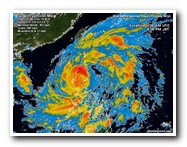Monday, Oct.18.2010 The official international name of the storm is Megi, which means “catfish” in Korean. But the storm is known locally in the Philippines as “Juan”, as the Philippine Atmospheric,
Geophysical and Astronomical Services Administration has its own naming system. The world's strongest tropical cyclone of 2010 is Super Typhoon Megi, which hits the the PHILIPPINES
and intensified into an extremely dangerous Category 5 super typhoon with 180 mph winds this morning. There is a hurricane hunter aircraft in Megi, as part of the Interaction of Typhoon and Ocean Project (ITOP), which is studying how the ocean responds to typhoon growth and movement in the Western Pacific Ocean. As part of ITOP, a C-130 hurricane hunter aircraft was in Megi this morning, and measured some truly remarkable winds and pressures. At 8:09am EDT (12:09 UTC), the aircraft measured winds at flight level (8,000 feet) of 220 mph. The SFMR surface wind measurement instrument recorded surface winds of 186 mph in regions where heavy rain was not contaminating the measurement, but found surface winds of 199 mph in one region of heavy rain. Now, this measurement is considered contaminated by rain, but at very high wind speeds, the contamination effect is less important than at lower hurricane wind speeds, and it is possible than Megi's surface winds are close to a sustained 200 mph. This is supported by the flight level winds of 220 mph, which support surface winds of 199 mph, using the usual 10% reduction rule of thumb. The Hurricane Hunters measured a surface pressure of 893 mb at 12 UTC. This is a phenomenally low pressure, ranking Megi as the 20th strongest typhoon ever recorded in the Western Pacific. Only three Atlantic hurricane have been more intense than Megi--Wilma (2005) at 882 mb, Gilbert (1988) at 888 mb, and the 1935 Labor Day Hurricane, at 892 mb. Megi's intensity easily beats out 2010's other two Category 5 storms, March's Tropical Cyclone Ului in the South Pacific and the East Pacific's Hurricane Celia of June, which both peaked at 160 mph winds. It is still possible that Megi will intensify further, as wind shear is low, less than 10 knots, SSTs are very warm, and the ocean has a very high total heat content.
Megi is poised to deal a devastating blow to the northern portion of the Philippines' Luzon Island early Monday morning. If the super typhoon's winds stay near 180 mph, the damage will be catastrophic in the
regions where the eyewall makes landfall. The Philippines government is taking Megi very seriously, and has ordered evacuation of all low-lying regions in Megi's path. Equally dangerous will be Megi's torrential rains,
which will likely be more than 12 inches over wide regions of northern Luzon, creating dangerous mudslides and life-threatening flash floods. Once Megi crosses Luzon, the storm is expected to re-intensify and hit the
Chinese coast between Hainan Island and Hong Kong as a major typhoon on Friday. Storm chaser James Reynolds is in northeast Luzon, and will be shooting pictures and video that he will upload his website typhoonfury.com,
and Twitter, @TyphoonFury. The popular tourist and diving spot MALAPASCUA Island, north of CEBU in the Visayan Sea, will not be affected, but also strong winds from the west coast are present.
More info see under : http://www.wunderground.com/tropical/tracking/wp201015_sat.ht ml#a_topad Tropical Storm Tracking Map:
http://www.wunderground.com/tropical/tracking/wp201015_flasht
ool.html?extraprod=flashtool#a_topad |



